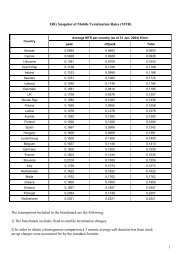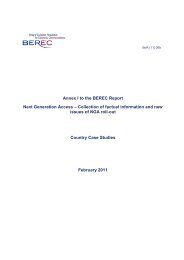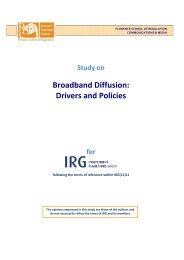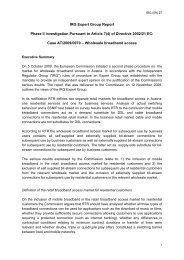You also want an ePaper? Increase the reach of your titles
YUMPU automatically turns print PDFs into web optimized ePapers that Google loves.
Figure 1. The security market line and the <strong>WACC</strong><br />
Required Expected return<br />
R B<br />
R firm<br />
R A<br />
R f<br />
ER A<br />
β A β firm β B<br />
<strong>IRG</strong>-WG RA (<str<strong>on</strong>g>07</str<strong>on</strong>g>) <strong>WACC</strong> Master Doc<br />
ER B<br />
Project<br />
<strong>WACC</strong><br />
Company <strong>WACC</strong><br />
Project beta<br />
These implicati<strong>on</strong>s can be analysed both from the point of view of the company and of the<br />
regulator.<br />
From the company’s point of view, if the company <strong>WACC</strong> is used for making investments<br />
appraisal decisi<strong>on</strong>s, all services/products, rather than a project <strong>WACC</strong>, i.e. the <strong>WACC</strong><br />
reflecting the systematic risk and expected return of the particular services/products, there is<br />
a possibility of sub-optimal decisi<strong>on</strong>s being made: for example, a firm will accept some higher<br />
risk projects (e.g. project B in figure 1) which should be rejected because the return they are<br />
expected to yield (ERb) whilst higher than the company’s <strong>WACC</strong> (Rfirm) is lower than the<br />
project <strong>WACC</strong> (Rb). C<strong>on</strong>versely, the firm will reject some lower risk project (e.g. Project A)<br />
which should be accepted – because the return they are expected to yield (ERA) whilst lower<br />
than the company’s <strong>WACC</strong> (Rfirm) is higher than the project <strong>WACC</strong> (ERA).<br />
From the regulatory point of view, the figure may be interpreted as showing the actual<br />
different level of risk (beta) associated with different regulated products <strong>on</strong> the horiz<strong>on</strong>tal axis<br />
and the corresp<strong>on</strong>ding expected rate of return, <strong>on</strong> the vertical axis. NRAs should evaluate<br />
whether rewarding projects with a different level of systematic risk is c<strong>on</strong>sistent with<br />
regulatory best practice. In fact, the use of differentiated betas, by preventing excessive<br />
returns being earned <strong>on</strong> low risk products, will discourage inefficient investments and<br />
promote efficient investments, and, at the same time, improve c<strong>on</strong>sumers’ welfare with<br />
regard to such products, by promoting downstream competiti<strong>on</strong>.<br />
However, the lack of capital market informati<strong>on</strong> at divisi<strong>on</strong>al level makes the theoretically<br />
correct determinati<strong>on</strong> of the proper risk premium difficult. And the estimates used for listed<br />
companies are not applicable as company divisi<strong>on</strong>s are usually not traded <strong>on</strong> the stock<br />
market and therefore do not have a share price. Moreover, the problem of how to calculate<br />
the weights in the beta disaggregating formula should be addressed, as market values may<br />
26<br />
Formatted







